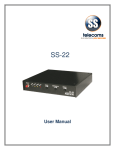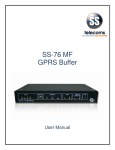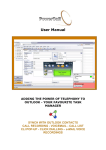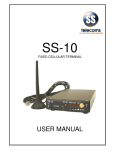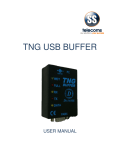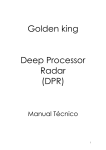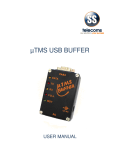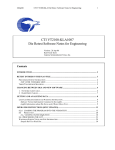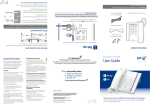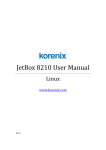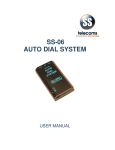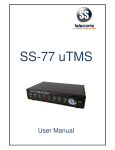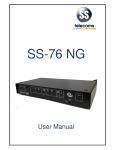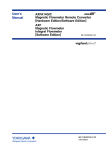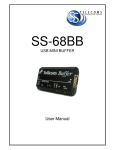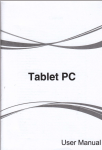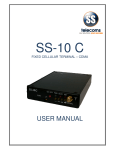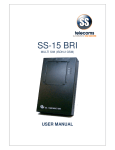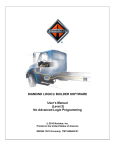Download SS 75MF LAN BUFFER USER MANUAL
Transcript
SS-75 LAN BUFFER MAX FLASH VERSION USER MANUAL DOC. NO.: SS-75MF-14 (REV. 02) Page 1 of 25 Revision history Revision 01 Cosmetic changes January 2008 CONTENTS 1. PURPOSE ....................................................................................................................................... 3 2. FEATURES...................................................................................................................................... 3 3. DESCRIPTION ................................................................................................................................ 4 3.1 FULL beeper .................................................................................................................................... 4 3.2 RESET switch.................................................................................................................................. 4 3.3 LED .................................................................................................................................................. 4 4. LAN Buffer Installation and Setup ................................................................................................... 6 5. SETTING THE LINKS...................................................................................................................... 7 6. PROGRAMMABLE SETTINGS FOR THE NETWORK INTERFACE ............................................ 7 7. Programmable Settings for the Call Logging Buffer ..................................................................... 10 8. PROTOCOL MODE....................................................................................................................... 12 9. TECHNICAL SPECIFICATIONS ................................................................................................... 13 APPENDIX A: HYPERTERMINAL SETUP ...................................................................................................... 14 APPENDIX B: LOADING TELNET ................................................................................................................... 15 APPENDIX C: SS-75 Web Interface ................................................................................................................ 16 1. CONFIGURING THE IP ADDRESS VIA THE SERIAL PORT ..................................................... 16 2. CONNECTING THE LAN BUFFER ............................................................................................. 17 3. ACCESSING THE WEB INTERFACE .......................................................................................... 18 4. CONFIGURATIONS ...................................................................................................................... 18 10. CONTACT DETAILS ..................................................................................................................... 25 DOC. NO.: SS-75MF-14 (REV. 02) Page 2 of 25 1. PURPOSE The SS-75 LAN buffer is a Call Logging Buffer fitted with an Ethernet Interface for the retrieval of call records via a local (LAN) or wide (WAN) area network. PABX MAINTENANCE PORT CALL DATA LAN---------------------------------------------------------------------------------2. FEATURES ? ? Improved easier MMI commands and set-up ? ? 10/100 Base-T Ethernet (Auto detection) ? ? IP configuration settable over the network ? ? Password access ? ? PABX Maintenance Port ? ? Single point LAN to LAN buffering ? ? Remote Buffer setup and download ? ? PC serial port for set up of the Network Interface. ? ? 128 Kbytes to 256 Mbytes of RAM can be supplied. ? ? PABX connection Opto-Coupled ? ? The logging baud rate can be set from 1200 baud to 19200 baud. ? ? Battery backup will allow storing of call records in buffer. ? ? Beeper warning when the buffer is full. ? ? LED status indications. DOC. NO.: SS-75MF-14 (REV. 02) Page 3 of 25 3. DESCRIPTION FRONT PANEL 3.1 FULL beeper Sounds when the unit has been reset, during a memory test or when the buffer is full. 3.2 RESET switch Used for resetting the Buffer and the Network Interfac e. 3.3 LED (Light Emitting Diodes) Indicators LED POWER PC RX & TX PABX RX & TX BUFFER 50% & 80% Description Indicates that the unit is supplied with a mains voltage Flashes when downloading call records. Indicates transmission to and from the network Interface when setting up the Network Interface. The RX LED flashes very dimly because of high speed and low character rate during transmission RX – Indicates data reception from the PABX port TX – Transmission to the PABX is not implemented Flashes when the buffer reach 50% and 80% of the full capacity. The 50% and 80% LED indicators flashes during the memory test. BUFFER ‘heart’ Indicates that the Buffer’s CPU is running LINK A network link is established 10 Indicates network speed is 10M bps 100 Indicates network speed is 100M bps Indicates a packet transmitted from the Ethernet controller to the network has collided with another packet. If the LED flashes more than once a second the system administrator needs to be consulted COL DOC. NO.: SS-75MF-14 (REV. 02) Page 4 of 25 REAR PANEL Mains Input Cable # 2 Connects the unit to a 230VAC 50 Hz power source 3 5 4& 7 6& 8 PABX COMPUTER DB9 MALE DB9 FEMALE Description Receive from PABX Transmit to PABX (not implemented) Common ground signal Handshake to PABX Handshake from PABX DOC. NO.: SS-75MF-14 (REV. 02) # Description 2 Transmit to PC 3 Receive from PC 4 Handshake from PC 5 Ground The cable connecting the unit to a PC is a simple ‘1 to 1’ cable with only pins 2, 3, 4 and 5 being used. LAN 120 ? RJ -45 connector # Description 1& 2 LAN Receive 3& 6 LAN Transmit Page 5 of 25 4. LAN Buffer Installation and Setup Change the links if needed Refer to the section ‘5. Setting the Links’ for more information Connect the unit to a PC Use the serial cable and connect it between the PC and the COMPUTER connector on the LAN BUFFER. Load a COMS package like Hyper Terminal Set the parameters to: Bits per second: 9600; Data bits: 8; Parity: None; Stop bits: 2; Flow control: None Refer to “Appendix A HyperTerminal setup” Connect power to the unit Plug the unit into a 220V mains socket and switch it on. Note: If the batteries on the unit were discharged it will start with a memory test. The 50% and 80% LEDs flash during this test. Wait for the memory test to finish. The unit will reset after the memory test Configure the Network Interface Connect the unit to the LAN Use TELNET to access the buffer via the LAN Configure the Call Logging Buffer Set date/time insertion if needed. DOC. NO.: SS-75MF-14 (REV. 02) Set the Local IP Address; Subnet Mask & Gateway Address The command are: LI: Sets the Local IP Address SM: Sets the Subnet Mask GA :Sets the Gateway Address Type the command followed by a space and then the address value followed by Enter, example: LI 192.168.0.16 Refer to the Section “6. Programmable Settings for the Network Interface” in this manual for more information. Note: The default settings are suitable for most applications Plug the network 10/100 Base-T RJ45 connector into the 10/100 Base-T socket at the back of the unit From your desktop click on ‘START’ then 'RUN' and then type telnet - click OK. Refer to “Appendix B Load Telnet” Set the PABX communication speed using the command SETBAUD. Type the command followed by a space and then the required speed followed by Enter, example: SETBAUD 9600 If the date and time are not included on the PABX call record, you need to set the buffer to include it in the call record. Check the PABX call record by typing S followed by Enter. Use the followin g commands to set date/time insertion: YP – Set the insertion position; SD –date insertion; YY – year insertion; YC – century insertion; TIME - Sets the time. Refer to the Section “7. Programmable Settings for the Call Logging Buffer” in this manual for more information. Page 6 of 25 5. SETTING THE LINKS The links need to be changed from the default positions if: ? The LAN Buffer is used with the Philips IS 1000 or Siemens Opera PABX systems ? Wanting to bypass the opto-couplers and connects directly to the PABX input ? A Positive feed is required to the PABX Unscrew the top four screws and remove the lid to change the Links inside the unit. Link 1 2 3 6. Position of Links Description Common Ground: Pin 5 of PABX connector, connected to buffer ground B Ground isolated: Pin 5 of PABX connector is isolated (factory) Voltage Feed: Feed positive voltage on Pin 2 of PABX connector B A B A Normal operation (factory) Direct input from PABX B (Requires LK 1 in pos B) Opto-Isolated input from PABX (factory) A (Recommend LK 1 in pos A) PROGRAMMABLE SETTINGS FOR THE NETWORK INTERFACE Note: The default settings are suitable for most applications Global commands - Format: <Command><cr> Command Description HELP Shows a list and description of all the Global commands SHOW Shows the Global settings MAC address and software version SHOW <n> n=G n = socket number LOAD Loads previous settings from Flash memory RESET REBOOT Displays the Global settings Displays the Settings for Socket number ‘n’ Resets the unit (Warm start). Breaks connections. The set-up stored in Flash memory will take affect. You will be prompted if you want to save changes. Resets the unit (Cold start). Breaks connections. The set-up stored in Flash memory will take affect. You will be prompted if you want to save changes. DOC. NO.: SS-75MF-14 (REV. 02) Page 7 of 25 Global Programmable commands - Format: <Command><Parameter><cr> Command Description LI Sets the Local IP Address SM Sets the Subnet Mask GA Sets the Gateway Address IR Sets the Initial Retry time in milliseconds Default: 200 RC Sets the Retry Counter Default: 6 DM Display Mode: ‘V’ Verbose; ‘S’ Silent Default: V HS Handshake Source - The command HS used without any parameters toggles the Handshake Source between Port 0 and Port 1 Default: Port 0 DOC. NO.: SS-75MF-14 (REV. 02) Note Use values supplied by Network administrator Page 8 of 25 Socket commands - Format: <Command><Socket#> <Parameter><cr> Command Description LP UT MT UM BS Note Set the local port number for the socket Socket reference table: Socket Function Connection TMS down load / buffer 0 Buffer set-up RS232 interface to 1 PABX Ethernet Network Maintenance 2 Ethernet connection Port Used Timed TX - Will send data after a short time delay. ‘Y’ will use Timed Tx. Note that VM & BS are always valid. Message Terminator – Will send the data after receiving the Message Terminator, enter a value in Hex. Use Message Terminator. ‘Y’ uses the message Terminator; ‘N’ won’t use the message Terminator. Block Size: Send the data after the retrieval of a block. Enter the size of the block Default values: Socket 0: 23 Socket 1: 22 Socket 2: 21 Default: N Default 0D (Carriage return) Default: Y Default 0 Default values: Socket0 57600 Socket1 - 9600 Note: Socket 0 must be set to 57600 in order to connect to the buffer PS Socket serial speed: 115200*, 57600*, 19200,9600,4800, 2400, 1200 * only available on Socket 0 RI Remote IP Address Must be set if Local mode is active RP Remote Port - Must be set if Local mode is active LM Local Mode Default: Passive LC ‘Y’ will do a Link Check Default: N DOC. NO.: SS-75MF-14 (REV. 02) Page 9 of 25 7. Programmable Settings for the Call Logging Buffer Note: The default settings are suitable for most applications Setup commands - <cr>after the instruction Command Description Note Sets the baud rate to the rate represented by the first 2 Set to: SETBAUD <nn> characters 'nn'. e.g. use 12 for 1200bd. Note: the 9600 bd full baud rate can be used, (SETBAUD 9600<cr>) SETHELLO Sets the buffer name to <bufnam> - MUST be a 6 char name <bufnam> Sets the date insertion position 1= start of record YP <n> If the date/time 0 = end of record are not included Enables date insertion. 1 = enabled, SD <n> in the call record 0 = disabled received from Enables year insertion. 1 = enabled, the PABX, it YY <n> 0 = disabled needs to be Enables century insertion. 1 = enabled, enabled YC <n> 0 = disabled BEEP <n> Enables BEEPING. 1 = enabled, 0 = disabled SAD <n> Enables autodump mode. 1 = enabled, 0 = disabled SAT <n> Sets the delay before dumping to nn * 50 millisec. Sets OnEmpty delay to nn* 50 millisec or the ST <nn> NonAckedResendDelay RT <nn> Sets the number of retries for a UnAcked packet SPR <nn> Sets the reset time for the Network I/F in minutes. n = 00 to disable UC <n> Converts lowercase to uppercase. 1 = enabled, 0 = disabled LF <n> Stores multiple line feeds. 1 = enabled, 0 = disabled TIME Sets the time YYMMDDhhmmss 7 Bit operation if n = 1. S7 <n> Note: use for 7 bit only operation, do not use for 7 bit with parity. ISDX mode converts Julian Date to YYMMDD for ISDX systems ISDX <n> 0 = disabled ;1 = enabled; 2 = enabled with decoding; 3 = enabled with decoding for use with SPACO PROT <n> Turn on protocol (packet mode) 1 = enabled, 0 = disabled DOC. NO.: SS-75MF-14 (REV. 02) Page 10 of 25 Call Logging & Diagnostic Commands - <cr>after the instruction Command Description S or SEND Send one record HELLO Response is: <02h><SixCharId><SixCharId><cr><lf> VER Will output the revision number of the MTS unit Diagnostic command. Do NOT use in logging program to get buffer status! SYS DUMP Empty buffer quickly. Do not use for collecting records CLEAR Clears the buffer TIME Response is: TIME YYMMDDHHhhmmss<cr><lf> DISP Displays some buffer setup info Displays approximate buffer capacity in records e.g. 4K<cr><lf> for a 128k buffer Outputs the number of calls in the buffer Displays the number of resets and clears the reset counter for the Network Interface Sends nn records using following format: DataBlock<cr><lf> < r <record 1><cr><lf> ‘‘ ‘‘ <record nn><cr><lf> TotalRecords nn<Kr><lf> (nn may be less than the num ber requested, depending on how many records were available for sending.) To display buffer capacity and used memory. Response is: MstatccSSSSSSccUUUUUU<cr><lf> Where: cc is used internally and has no useful meaning. SSSSSS is the hex value of the memory installed. UUUUUU is the amount of memory used. e.g. Mstat0002000000000101 means that the buffer has 128k ram fitted and there are 257 bytes of data in the buffer /B /C DPRC SEND nn MM DOC. NO.: SS-75MF-14 (REV. 02) Page 11 of 25 8. PROTOCOL MODE 8.1 Packet Mode Control commands 8.2 ctrl Q Start packet output. ctrl F Acknowledge packet. ctrl S Stop packet output. Packet Mode Format STX Start of packet - 0x2 <n> Sequence number '0' to '9' <n> Number of records '0' to '5' <ID> First 2 chars of buffer ID. <cr><lf> End of Header. Record1<cr><lf> Record2<cr><lf> Record3<cr><lf> Record4<cr><lf> Record5<cr><lf> <cr> **** This character is included if the chksum was going to be an ETX. <Checksum> The result of XORing all the previous bytes, including the STX. ETX End of packet. DOC. NO.: SS-75MF-14 (REV. 02) Page 12 of 25 9. TECHNICAL SPECIFICATIONS Housing Grey powder coated Aluminium 230 x 130 x 40 mm LED indicators PC TX & RX, PABX TX & RX, 80% and 50% full, Heart Beat, Power, LINK, 10-T, 100-H, COL Connecting to PC: 9 way D -Type female Connecting to PABX: 9 way D -Type male Network connection: 10/100 Base-T Connectors Storage medium Battery backed buffering Storage capacity 128K to 256Meg Required voltage 230 V AC; 50 Hz Current consumption 50 mA Battery backup 3.6 V 600 mA Ni-Cad. Powers data buffer for up to 3 weeks Transmission speed PORT 0: 2400bps ~ 115.2Kbps PORT 1: 1200bps ~ 19.2Kbps Network Interface Medium 10/100 Base-T (auto detect) Protocol TCP-IP or UDP-IP Time stamping of call records and events Data compression, typical ratio 2.5:1 Warning beeper at 95% full DTR enabled dumping of records ASCII handshake protocol Fully error corrected proprietary protocol Data storage DOC. NO.: SS-75MF-14 (REV. 02) Page 13 of 25 APPENDIX A: HYPERTERMINAL SETUP Load HyperTerminal from your PC. From the Desktop click on start, select 1 Programs, Accessories, Communications and then HyperTerminal In the Connection Description box 2 enter a name for the connection example ‘9600’ Click on OK In the Connect To window select 3 the required COM port in the Connect using box. Click on OK. In the COM Properties window set the parameters: Bits per second: 9600; Data bits 8; 4 Parity: None; Stop bits: 2; Flow control: None Click on OK DOC. NO.: SS-75MF-14 (REV. 02) Page 14 of 25 APPENDIX B: LOADING TELNET 1 Loading Telnet – Windows 1.1 From the PC desktop Click start and then Run 1.2 In the Run window type TELNET in the Open box and click OK 1.3 2 2.1 Connect to the Buffer setup port: Click onto Connect Enter the IP address for the Buffer setup port in the Host Name box and click Loading Telnet - Windows XP From the PC desktop Click start and then Run 2.2 In the Run window type TELNET in the Open box and click OK 2.3 Connect to the Buffer setup port: Type the command OPEN followed by a space and then the address value followed by Enter, example: DOC. NO.: SS-75MF-14 (REV. 02) Page 15 of 25 APPENDIX C: SS-75 Web Interface 1. CONFIGURING THE IP ADDRESS VIA THE SERIAL PORT 1.1. Use the serial cable to connect between the PC and the computer connector of the LAN BUFFER 1.2. Open HyperTerminal on the PC with the following communication ports setting. 1.3. Press the reset button on the LAN Buffer. In HyperTerminal the following information will be displayed. DOC. NO.: SS-75MF-14 (REV. 02) Page 16 of 25 1.4. Configure the Local IP address, Subnet mask and Gateway as follow: To change the following you must type Set the local IP address : LI Eg: LI 192.168.10.100 <enter> Set the subnet mask : SM Eg: SM 255.255.255.0 <enter> Set the gateway Address Eg: GA 192.168.10.1 <enter> : GA To save the setting type RESET S enter 2. CONNECTING THE LAN BUFFER 2.1. Connect the Buffer’s LAN port to: a) A network switch using a Straight LAN cable Or b) Directly to a PC using a Cross over LAN cable. 2.2. Make sure that the PC and the Buffer are in the same IP Subnet. 2.3. Open the TCP/IP Properties to configure the PC’s IP address DOC. NO.: SS-75MF-14 (REV. 02) Page 17 of 25 3. ACCESSING THE WEB INTERFACE 3.1. Open Internet Explorer on the PC and type the Buffer’s IP address in the address field. The following will be displayed 4. CONFIGURATIONS DOC. NO.: SS-75MF-14 (REV. 02) Page 18 of 25 4.1. Global Settings Setting General Use DHCP Description Initial Retry Time (ms) Retry Count When ticked, the DHCP server will supply the buffer with a Local IP Address, Subnet Mask, Gateway Address and DNS Server. If this is not ticked the IP Address, Subnet Mask, Gateway Address and DNS Server has to be configured manually. Sets the IP address for the buffer. This has to be given in order for the PABX and TMS software to recognise the buffer. Identifies which level of the network the buffer is installed on. (A common default is 255.255.255.0) The address of the gateway or router the buffer is connected to The IP address for the server that translates domain names into IP addresses . Sets the Initial Retry time in milliseconds Set the Retry Counter Time-To-Live(hex) Time-To-Live. Default is 80 Display Mode Handshake Source Dictates whether the buffer echo’s text to the terminal Toggles the Handshake Source Between Port 0 and Port 1 Function Stand Alone will disable the buffer functionality of the unit. Buffers will enable the buffer functionality of the unit. IP Address Subnet Mask Gateway Address DNS Server TMS Use TMS TMS Server To enable the use of a TMS The IP address of the server where records will be sent to. Contact Interval Buffer ID The interval in minutes between contacting the TMS server. A user settable name for each buffer of up to 8 letters and/or numbers. This ID should be unique for each buffer. Time DOC. NO.: SS-75MF-14 (REV. 02) Page 19 of 25 Use Time Time Server Local Offset Enable the use of a time server Sets the address the buffer should connect to in order to obtain time from a time server. This can be done with an IP address or domain name. Sets the time zone in which the buffer functions, (e.g. in South Africa it will be GMT +2 hours, therefore set the time to 120 minutes). This time is always set in minutes. 4.2. SETTINGS FOR SOCKET 0 Setting Ports Local Description Port No Identifies the TCP port your connection communicates with socket 0 Connection speed used when communicating with Buffer via TCP. This should always be set to 57600. Sets the Data bits and Parity port settings. Default is 8/None Baud Rate Bits/Parity Ports Remote Port No IP Address Conditions to Transmit Inter-character Time Terminator Char(hex) Block Size The port on the TMS Server that the buffer will communicate to. Only applicable when socket is set to Active Mode. The IP address on the TMS Server that the buffer will communicate to. Only applicable when socket is set to Active Mode. Enable Inter-character Time Will send the data after receiving the Message Terminator. Enter a value in Hex Block Size: Send the data after the retrieval of a block. Enter the size of the block General No-activity time(mins) Password No activity time out Password of the socket Link Check Will do a Link Check Mode Dictates whether the buffer establish the connection(Set to Active) Or if the server establish the connection(Set to Passive) Default mode is Passive. TCP or UDP Protocol DOC. NO.: SS-75MF-14 (REV. 02) Page 20 of 25 4.3. SETTINGS FOR SOCKET 1 Setting Ports Local Port No Baud Rate Bits/Parity Ports Remote Port No IP Address Conditions to Transmit Inter-character Time Terminator Char(hex) Block Size General No-activity time(mins) Password Avaya Prompt(hex) Link Check Mode Protocol Description Identifies the TCP port your connection communicates with socket 1 Connection speed used when communicating with Buffer via TCP. Default is 9600 Sets the Data bits and Parity port settings. Default is 8/None The port on the TMS Server that the buffer will communicate to. Only applicable when socket is set to Active Mode. The IP address on the TMS Server that the buffer will communicate to. Only applicable when socket is set to Active Mode. Enable Inter-character Time Will send the data after receiving the Message Terminator. Enter a value in Hex Block Size: Send the data after the retrieval of a block. Enter the size of the block No activity time out Passwor d of the socket The hex value for the Avaya Will do a Link Check Dictates whether the buffer establish the connection (Set to Active) Or if the server establish the connection (Set to Passive) Default mode is Passive. TCP or UDP DOC. NO.: SS-75MF-14 (REV. 02) Page 21 of 25 4.4. SETTINGS FOR SOCKET 2 Setting Ports Local Port No Description Identifies the TCP port your connection communicates with socket 2 Conditions to Transmit Inter-character Time General Enable Inter-character Time No-activity time(mins) No activity time out Password Mode Password of the socket Dictates whether the buffer establish the connection (Set to Active) Or if the server establish the connection (Set to Passive) Default mode is Passive. TCP or UDP Protocol 4.5. SAVE SETTINGS Setting NIC Save Options Save Changes Save Changes and Reboot NIC Reboot NIC Description Save all changes without rebooting Save all changes and reboot system Reboot system without saving changes DOC. NO.: SS-75MF-14 (REV. 02) Page 22 of 25 4.6. SET PASSWORD Setting Set Password User Name Enter Password Re-enter Password Description Set user name for the Web interface Set password for the Web interface Confirm password 4.7. BUFFER SETTINGS Setting Record Modifiers Description Convert to uppercase 7-Bit operation Store multiple linefeeds Binary mode STX (hex) Converts lowercase to uppercase Use for 7 bit only operation Stores multiple line feeds Set the logging to binary mode To set the start character for a record. All data will be discarded until this character is received. Default is FF The call record will be terminated when the ETX character is received. An End OF Line character will be stored in memory and will be output as a Carriage Return / Linefeed pair. Default is 0D Enables the date insertion to the record ETX (hex) Date and Time Insertion DOC. NO.: SS-75MF-14 (REV. 02) Page 23 of 25 Insert Year Insert Century Insert date at: General PABX Baud Rate Buffer Name Beep enabled Autodump enabled Autodump delay (x 50 mS) Send timer (x 50 mS) Retry Count Network reset time (mins) Software Version: Date / Timer Date Time Enables year insertion Enables century insertion Sets the date insertion position Sets the baud rate of the PABX port Sets the buffer name. MUST be a 6 character name Enables Beeping Enables auto dump mode Sets the delay before dumping Sets OnEmpty delay Sets the number of retries for a UnAcked packed Sets the reset time for the Network I/F Will output the revision number of the buffer Sets the date Sets the time DOC. NO.: SS-75MF-14 (REV. 02) Page 24 of 25 10. CONTACT DETAILS Office: 23 Botha Avenue Lyttelton Manor Pretoria, Gauteng South Africa Tel: Fax: E-mail: +27 12 664 4644 +27 86 614 5625 [email protected] Postal address: Postnet Suite 48 Private Bag x 1015 Lyttelton, 0140 Pretoria, Gauteng South Africa Sales Support: e-mail: [email protected] United Kingdom e-mail: [email protected] Technical Support: E-mail: DOC. NO.: SS-75MF-14 (REV. 02) [email protected] Page 25 of 25

























